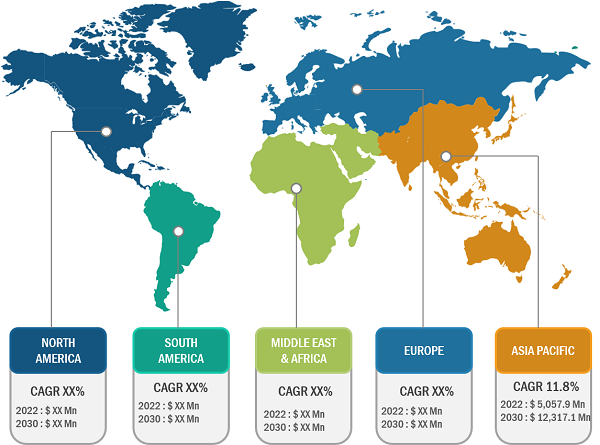Integration of Real-Time Communication Feature to Offer Opportunities for Vital Signs Monitoring Devices Market
According to our new research study on "Vital Signs Monitoring Devices Market Forecast to 2030 – Global Analysis – by Product and End User," the market size was valued at US$ 25,617.24 million in 2022 and is expected to reach US$ 66,824.03 million by 2030. It is estimated to grow at a CAGR of 12.7% from 2022 to 2030.
The adoption of remote access features in healthcare, and advancements in audio and video technologies have bridged the gap between patients and accessing healthcare services. Thus, telemedicine has gained noticeable popularity and has paved the way for real-time communication (RTC). The integration of the RTC feature in vital sign monitoring devices is expected to allow patients to connect with healthcare providers efficiently according to their comfort to receive virtual consultations and essential medical services.
Vital Signs Monitoring Devices Market Size and Forecasts (2020 - 2030), Global and Regional Share, Trends, and Growth Opportunity Analysis Report Coverage: By Product (Pulse Oximeters, Blood Pressure Monitors, Temperature Monitoring Devices, and Glucose Monitoring Devices), End User (Hospitals and Clinics, Ambulatory Care Centers, Home Healthcare, and Others), and Geography (North America, Europe, Asia Pacific, Middle East & Africa, and South & Central America)
Vital Signs Monitoring Devices Market Strategies by 2030
Download Free Sample
Companies are developing products that incorporate real-time technologies to allow the efficient monitoring of patients' vital signs. In March 2023, Vigilant Medical Solutions, LLC announced the development of the Guardian mobile app and medical device solution that would send real-time alerts on the smartphones of in-hospital anesthesiologists when there is a change in patients’ vitals. Guardian is incorporated with artificial intelligence technology that provides vital updates on postoperative delirium, stroke, acute kidney injury, and death. Vigilant Medical Solutions, LLC claims that Guardian is designed to provide easy access to patients' vitals when doctors are busy treating several patients in different rooms or operating rooms. In October 2021, Honeywell launched a Realtime Health Monitoring System (RTHMS). RTHMS is a smart edge-to-cloud communication platform intended for the remote and real-time monitoring of patients. This mobile app for caregivers alerts them after any deviation in a patient’s abnormal vitals. The company has also claimed that using RTHMS would reduce hospital administrative tasks by 35%. Adopting and installing such innovative technologies in healthcare facilities worldwide would benefit the healthcare sector and enhance patient health quality. Thus, the integration of real-time communication features is likely to propel the vital signs monitoring devices market in the coming years.
The vital signs monitoring devices market is segmented as follows:
The global vital signs monitoring devices market has been analyzed and segmented on the basis of end user, product, and geography. Based on product, the market is classified into blood pressure monitors, temperature monitoring devices, pulse oximeters, and glucose monitoring devices. In 2022, the glucose monitors segment held the largest market share, and the pulse oximeters segment is anticipated to register the fastest CAGR during 2022–2030. Further, the glucose monitors are subsegmented into self-glucose monitoring and continuous glucose monitoring devices.
On the basis of end user, the vital signs monitoring devices market is segmented into hospitals and clinics, ambulatory care centers, home healthcare, and others. The hospitals and clinics segment accounted for the largest market share in 2022. The home healthcare segment is estimated to register the fastest CAGR during 2022–2030.
Region Analysis – Vital Signs Monitoring Devices Market
In terms of geography, the global vital signs monitoring devices market is segmented into North America, Europe, Asia Pacific, the Middle East & Africa, and South & Central America. North America held the largest market share during 2022–2030. The market in this region is split into the US, Canada, and Mexico. The growth of the market in this region is attributed to factors such as the rise in respiratory diseases, a large pool of diabetic population, and an increase in awareness about chronic diseases among the population.
A rise in product approvals and launches in the US is further expected to boost market growth over the forecast period. For instance, in August 2020, Stasis Labs announced the US launch of their mobile-connected remote patient monitoring technology for hospital and outpatient use. The Stasis system includes a smart device, a bedside monitor, conventional vital sign sensors, and a supporting cloud platform. Moreover, in January 2022, Aktiia unveiled a plan to launch its automated 24/7 blood pressure monitor in the US. The new device is designed to gather more than 100 readings of the blood pressure data compared to other monitors and provides 10 times more engagement.
Koninklijke Philips NV, Medtronic Plc, Nihon Kohden Corp, GE HealthCare Technologies Inc, OMRON Corp, Nonin Medical Inc, SunTech Medical Inc, Masimo Corp, Contec Medical Systems Co Ltd, and Baxter International Inc. are among the leading companies operating in the vital signs monitoring devices market.
Contact Us
Phone: +1-646-491-9876
Email Id: sales@theinsightpartners.com